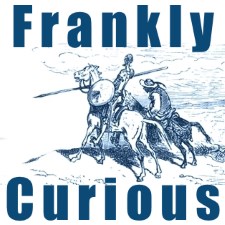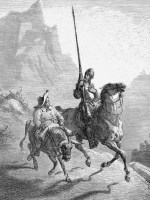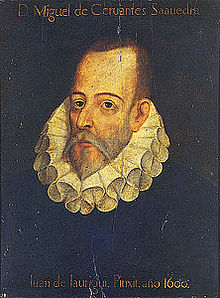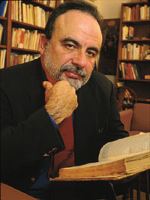In my research for it, I came upon a passage in the introduction to Samuel Putnam’s 1949 translation, “The version published by T G Smollett in 1755 merits little consideration as it is merely a working over of Jarvis.” That shocked me for a few reasons. One is that I’d read that introduction before — admittedly when I knew little of the English language translations of Don Quixote. But more important, it shocked me because the Tobias Smollett translation is still one of the most popular. It is the translation that Barnes & Noble uses for its classics edition.
It should be noted that Smollett was one of the greatest English language writers of the 18th century. The reason most people don’t know his name is because we don’t read much 18th century literature — certainly not like we read 19th century literature. Smollett went on to be quite a wealthy man. But when he took the commission to translation Don Quixote, he wasn’t doing well financially. So his lapse is ethics can be at least somewhat excused. And if not that, understood.
- Cervantes (1615)
-
“Ea, pues, a la mano de Dios!” dijo Sanch, “Yo consiento en mi mala ventura; digo que yo acepto la penitencia, con las condiciones apuntada.”
Apenas dijo estas ultimas palabras Sancho, cuando volvio a sonar la musica de las chirimias y se volvieron a disparar infinitos arcabuces, y Don Quijote se colgo del cuello de Sancho, dandole mil besos en la frente y en las mejillas. La Duquesa y el Duque y todos los circunstanes dieron muestras de haber recebido grandisimo contento, y el carro comenzo a caminar; y al pasas la hermosa Dulcinea, inclino la cabeza a los Duques y hizo una gran reverencia a Sancho.
Y ya, en esto, se venia a mas andar el alba, alegre y risuena; las florecillas de los campos se descollaban y erguian, y los liquidos cristales de los arroyuelos, murmurando por entre blancas y pardas guijas, iban a dar tributo a los rios que los esperaban. La Tierra alegre, el cielo claro, el aire limpio, la luz serena, cada uno por si y todos juntos daban manifiestas senales que el dia que al aurora venia pisando las faldas habia de ser sereno y claro. Y satisfechos los Duques de la caza, y de haber conseguido su intencion tan discreta y fellcemente, se volvieron a su castillo, con prosupuesto de segundar en sus burlas; que para ellos no habia veras que mas gusto les diesen.
- Cervantes – Literal Translation
-
“Turn then, the hand of God!” Sanch said, “I agree to my bad luck; I say I accept the penance, with the targeted conditions.
Just as Sancho said these last words the music sounded again and the chirimias infinite muskets fired again, and Don Quixote hung on Sancho’s neck, kissing him on the forehead and cheeks. The Duchess and the Duke and all circunstanes showed signs of having received any grandisimo happy, and the car began to walk; and you spend the beautiful Dulcinea, I bow my head to the Dukes and bowed deeply to Sancho.
And, in this, it came to more walking dawn, happy and cheerful; the florets of the fields decollaban and stood, and liquid crystals rills, muttering between white and brown pebbles were to give tribute to the rivers that awaited them. Earth cheerful, clear sky, clean air, the serene light, each for himself and all the signs manifest juntosdaban day at dawn came treading on the skirts had to be calm and clear. And satisfied the Dukes of hunting, and have gotten his intention so discreet and happily, returned to his castle, with budget of [double meaning?] in their taunts; that they had not really given them that taste more.
- Shelton (1620)
-
“Well,” quoth Sancho, “a God’s name be it! I yield to my ill fortune and with the aforesaid condition accept of the penitence.”
Scarce had Sancho spoken these words when the waits began to play, and a world of guns were shut off, and Don Quixote hung about Sancho’s neck, kissing his cheeks and forehead a thousand times. The duke, the duchess, and all the bystanders, were wonderfully delighted, and the cart began to go on, and, passing by, the fair Dulcinea inclined her head to the dukes, and made a low courtsy to Sancho. And by this the merry morn came on apace, and the flowers of the field began to bloom and rise up, and liquid crystal of the brooks, murmuring through the great pebbles, went to give tribute to the rivers, that expected them; the sky was clear, and the air wholesome, the light perspicuous; each by itself, and all together, showed manifestly that the day whose skirts Aurora came trampling on, should be bright and clear.
And the dukes being satisfied with the chase, and to have obtained their purpose so discreetly and happily, they returned to their castle, with an intention to second their jest; for to them there was no earnest could give more content.
- Phillips (1687)
-
“Go too then,” cried Sancho, “I submit to my misfortune, and accept my pennance upon the conditions and covenants agreed upon.” Sancho had no sooner spoken the last words, but the fiddles strook up again, and three volleys of small shot testified the general joy of madam Dulcinea and her friends, for her approaching freedom: Don Quixote also threw himself about the pious squires neck, and kissed his cheeks and forehead a hundred times; the duke and duchess were well pleased; and then the chariot beginning to move, the fair Dulcinea bowed her head and made a low obeisance to Sancho. And now the sun began to guild the tops of the mountains; at what time the duke and duchess infinitely satisfied that their design had succeeded so well, returned to the castle with their guests, resolved to continue the pasttime which had hitherto given them so much content.
- Motteux (1700)
-
“Well,” quoth Sancho, “what must be, must be: I yield to my hard luck, and on the aforesaid terms, take up with my penance.
Scarce had Sancho spoke, when the music struck up again, and a congratulatory volley of small shot was immediately discharged. Don Quixote fell on Sancho’s neck, hugging and killing him a thousand times. The duke, the duchess, and the whole company seemed mightily pleased. The chariot moved on and as it passed by, the fair Dulcinea made the duke and duchess a bow, and Sancho a low courtsy.
And now the jolly morn began to spread her smiling. Looks in the eastern quarter of the skies and the flowers of the field to disclose their bloom folds, and raise their fragrant heads. The brooks now cool and clear, in gentle murmurs, played with the grey pebbles and flowed along to pay their liquid tribute to the expecting rivers. The sky was clear, the aire serene, swept clean by brushing winds for the reception of the shining light, and every thing not only jointly, but in its separate Gaiety, welcomed the fair Auroa, and, like her, foretold a fairer day. The duke and duches, well pleased with the management and success of the hunting, and the counterfeit adventure, returned to the castle; resolving to make a second essay of the same nature, having received as much pleasure from the first, as any reality could have produced.
- Stevens (1742)
-
“Well,” quoth Sancho, a god’s name be it. I yield to my ill fortune, and on the aforesaid condition accept of the penance.”
Scarce had Sancho spoken these words, when the waits began to play, and a world of guns were shot off, and Don Quixote hung about Sancho’s neck, kissing his cheeks and forehead a thousand times. The duke, the duchess, and all the by-standers, seemed to be wonderfully pleased and the cart began to go on, and passing by, the fair Dulcinea bowed her head to the duke and duchess, and made a low courtesy to Sancho; and by this the merry morn came on apace, the flowers and the field began to bloom and rise up, the liquid crystal of the brooks, murmuring through the gray pibbles, went on to pay tribute to the rivers that expected them: the sky was clear, and the air serene, the light undistrubed each part, and all together were signs that the day which trod upon the heels of Aurora would be bring and clear. The duke and duchess being satisfied with the hunting, and well contrived and happy. Success of thei design, returned to the castle, with an intention to second their jest; for to them nothing in earnest could be more pleasing.
- Jarvis (1748)
-
“Go to, then, in God’s name,” quoth Sancho; “I submit to my ill fortune; I way, I accept of the penance upon the conditions stipulated.”
Scarely had Sancho uttered these words when the music of the waits struck up, and a world of muskets were again discharged, and Don Quixote clung about Sancho’s neck, giving him a thousand kisses on the forehead and cheeks. The duke and duchess, and all the bystanders gave signs of being mightily pleased, and the car began to move on; and, in passing by, the fair Dulcinea bowed her head to the duke and duchess, and made a low curtsy to Sancho. By this time the cheerful and joyous dawn came apace, the flowerets of the field expanded their fragrant bosoms, and erected their heads; and the pebbles, went to pay their tribute to the rivers that expected them, and all together, giving manifest tokens, that the day which trod upon Aurora’s heels would be fair and clear. The duke and duchess, being satisfied with the sport, and having executed their design so ingeniously and happily, returned to their castle, with an intention of seconding their jest; since nothing real could have afforded them more pleasure.
- Smollett (1755)
-
“A God’s name then,” cried Sancho, “I consent in my tribulation: I say, I accept of the penance on the conditions aforesaid.”
Scarce had Sancho pronounced these last words, when the music of the waits began to play again, and an infinite number of muskets was discharged, while Don Quixote, hanging about Sacho’s neck, imprinted a world of kisses on his cheeks and forehead: the duke and duchess, and all the by-standers, expressed the utmost pleasure, and the beauteous Dulcinea, in passing, bowed to their graces, and made a profound curtsy to Sancho.
About this time, the cheerful smiling morn advanced; the flowrets of the field, with heads erect, diffused their fragrance; and the liquid crystal of the rills, brawling among the variegated pebbles, went sliding on to pay its tribute to the rivers, that waited to receive their customary dues: the joyous earth, the splended firmament, the buxom air, and light unclouded; each singly, and altogether joined, serene and fair. The duke and duchess, extremely well satisfied with the chase, as well as with the ingenious and fortunate execution of their design, returned to the castle, with full intention to perform the sequel of their jest; than which no real adventure could have given them more delight.
- Ormsby (1885)
-
“Well then, in God’s hands be it,” said Sancho; “in the hard case I’m in I give in; I say I accept the penance on the conditions laid down.”
The instant Sancho uttered these last words the music of the clarions struck up once more, and again a host of muskets were discharged, and Don Quixote hung on Sancho’s neck kissing him again and again on the forehead and cheeks. The duchess and the duke expressed the greatest satisfaction, the car began to move on, and as it passed the fair Dulcinea bowed to the duke and duchess and made a low courtesy to Sancho.
And now bright smiling dawn came on apace; the flowers of the field, revived, raised up their heads, and the crystal waters of the brooks, murmuring over the grey and white pebbles, hastened to pay their tribute to the expectant rivers; the glad earth, the unclouded sky, the fresh breeze, the clear light, each and all showed that the day that came treading on the skirts of morning would be calm and bright. The duke and duchess, pleased with their hunt and at having carried out their plans so cleverly and successfully, returned to their castle resolved to follow up their joke; for to them there was no reality that could afford them more amusement.
- Putnam (1949)
-
“Well, then,” said Sancho, “it’s in God’s hands. I accept my hard luck — I mean, I consent to the penance with the conditions that have been laid down.”
No sooner had he said this than the clarions struck up once more, accompanied by a great firing of muskets, and Don Quixote threw his arms about Sancho’s neck, giving him a thousand kisses on the forehead and on the cheeks. The duke and duchess and all the bystanders showed that they were very pleased, and as the cart got under way once more the beauteous Ducinea bowed to the ducal pair and dropped a low curtsy to Sancho.
With this, the merry-smiling, dawn hastened her coming, the little flowers in the fields lifted their heads, and the liquid crystal of the brooks, murmuring over their white and gray pebbles, went to pay tribute to the waiting rivers. The earth was joyous, the sky unclouded, the air limpid, the light serene, and each of these things in itself and all of them together showed that the day which was treading on the skirts of morning was to be bright and clear. Satisfied with the results of the chase and with having carried out their intention so cleverly and successfully, the duke and duchess now returned to their castle with the object of following up the jest which had thus been begun, as there was no serious occupation that gave them greater pleasure than this.
- Raffel (1996)
-
“All right, then! It’s in God’s hands!” said Sancho. “It’s my misfortune, and I accept it — that is, I accpet the whipping, but only on the conditions already noted.”
Sancho had scarcely uttered these last words when the soft, harmonious music began once more, and a million muskets sounded, and Don Quijote [sic] threw his arms around his squire’s neck, kissing his forehead and his cheeks a thousand times over. The duke and duchess, and everyone else present, seemed absolutely delighted, and the chariot began to move off — and as it passed, the beautiful Dulcinea bent her head to acknowledge the duke and duchess, and made a deep curtsy to Sancho.
By which time, too, happy, smiling dawn was upon them, revealing the little flowers of the fields, standing straight and tall; the liquid crystal of tiny streams went murmuring among smooth brown and white pebbles, hurrying to pay tribute to the waiting rivers. The whole Earth was happy, the skies were bright and clear, the air pure, the light peaceful and calm, each and all indicating that this day, already treading on dawn’s skirts, would be serene and untroubled. The duke and duchess, well satisfied with their night’s hunting, and with how neatly and discreetly their plan had been carried out, went back to their castle, intending to continue amusing themselves, for there was nothing in all reality which could have pleased them quite so much.
- Rutherford (2000)
-
“All right then, God’s will be done!” said Sancho. “I agree to my bad luck — I mean to say I accept my penance, on the conditions that I said.”
Hardly had Sancho finished speaking when the music of the shawms sounded out again, and countless muskets were fired once more, and Don Quixote draped himself around Sancho’s neck, mothering him in kisses on the forehead and the cheeks. The Duchess and the Duke and all the others showed signs of the greatest satisfaction, and the chariot began to move; and as the lovely Dulcinea went by she bowed her head to the Duke and Duchess and made a low curtsey to Sancho.
And now the happy, smiling dawn came on apace, the flowers in the fields all raised their heads and stood erect, and the liquid crystal of the streams, murmuring among pebbles brown and white, flowed along to pay its tribute to the expectant rivers. The happy earth, the bright sky, the clean air, the serene light — each and all gave the most manifest signs that the day that came treading on the skirts of the dawn was going to be calm and clear. And the Duke and the Duchess, happy with their hunt and with having achieved their aims so cleverly and successfully, returned to the castle, determined to play some more jests — because nothing done in earnest could provide them with more amusement.
- Grossman (2003)
-
“Well, well, then it’s in God’s hands,” said Sancho. “I consent to my bad fortune; I say that I accept the penance, with the conditions that have been stated.”
As soon as Sancho said these words, the music of the flageolets began to sound again, and an infinite number of harquebuses were fired, and Don Quixote threw him arms around Sancho’s neck and gave him a thousand kisses on his forehead and cheeks. The duchess and the duke and all those present gave signs of great contentment and joy, and the cart began to move, and as the beautiful Dulcinea passed by, she bowed her head to the duke and duches and made a deep curtsy to Sancho.
And now a joyful and smiling dawn quickly approached; the flowers of the fields raised their heads and stood erect, and the liquid crystal of the streams, murmuring over smooth white and gray pebbles, hurried to pay tribute to the rivers that awaited them. The joyful Earth, the bright sky, the clear air, the serene light, together and separately gave clear indications that the day that came treading on the skirts of the dawn would be calm and bright. And the duke and duches, satisfied with their hunt and with having achieved their ends so cleverly and successfully, returned to their castle, intending to continue with their deceptions, because for them, there really was nothing that gave them greater pleasure.
I think the biggest take away from this is that it is best to pick a more recent translation when reading Don Quixote. It’s also clear, as I’ve noted many times before, that the excessive praise given to Grossman is unwarranted. She’s excellent, but not really any different from any other modern translator.
 It’s often been said that Shakespeare is the broccoli of English literature: people consume it because they think it is good for them but they don’t really like it.
It’s often been said that Shakespeare is the broccoli of English literature: people consume it because they think it is good for them but they don’t really like it.
 This period produced one great work of literature that ranks ahead of all others. It is the tale of Don Quixote de la Mancha, authored in two parts by Miguel Cervantes. In our literary canon, the novel has come to dominate the other forms in modern times. And with respect to the novel we can say, “In the beginning was Cervantes.” The genre springs from his work. And even today, after four hundred years, how many novels can begin to compete with this one? It is a work of amazing flexibility; it piles layer upon layer of meaning. It can be studied in universities and performed in Broadway musicals. Cervantes’s genius was to be simultaneously great, complex, subtle, and yet packed with immediate popular appeal. Cervantes fills a great panorama and he perfects the art of the tragicomedy. What seems at first blush a farce, a comic send-up, turns into a work filled with pain, loss, horror and introspection. What seems at first shallow soon emerges, especially in the second part, as a work of great philosophical depth; of wit and profound and timeless wisdom.
This period produced one great work of literature that ranks ahead of all others. It is the tale of Don Quixote de la Mancha, authored in two parts by Miguel Cervantes. In our literary canon, the novel has come to dominate the other forms in modern times. And with respect to the novel we can say, “In the beginning was Cervantes.” The genre springs from his work. And even today, after four hundred years, how many novels can begin to compete with this one? It is a work of amazing flexibility; it piles layer upon layer of meaning. It can be studied in universities and performed in Broadway musicals. Cervantes’s genius was to be simultaneously great, complex, subtle, and yet packed with immediate popular appeal. Cervantes fills a great panorama and he perfects the art of the tragicomedy. What seems at first blush a farce, a comic send-up, turns into a work filled with pain, loss, horror and introspection. What seems at first shallow soon emerges, especially in the second part, as a work of great philosophical depth; of wit and profound and timeless wisdom. I am slowly writing what I consider a badly needed article,
I am slowly writing what I consider a badly needed article,  I know what you’re all thinking, “I don’t like this new website look!” But trust me, you’ll get used to it. This is hardly the first time that the website has changed. And every time it changes, people don’t like it at first and then they can’t even remember what it was like before.
I know what you’re all thinking, “I don’t like this new website look!” But trust me, you’ll get used to it. This is hardly the first time that the website has changed. And every time it changes, people don’t like it at first and then they can’t even remember what it was like before.


 There has been a lot of reporting on some recent scholarship by historian Julio Mayo that finds that Cervantes, author of Don Quixote along with a bunch of stuff you’ve probably never heard of, had a
There has been a lot of reporting on some recent scholarship by historian Julio Mayo that finds that Cervantes, author of Don Quixote along with a bunch of stuff you’ve probably never heard of, had a  I really want to get away from talking about politics. It’s just getting so boring. I mean, I enjoy it to some extent. But what is there to say? Saudi Arabia is an evil country that we pretend is good because they are an official ally. Said that (many times). The Republican Party is a proto-fascist revolutionary group that is far more dangerous than people will admit. Said that (many times). And the media pretend it isn’t true. Said that (many times). So I want to write about other things. And today, I thought that I would write about fashion — in particular, sneakers.
I really want to get away from talking about politics. It’s just getting so boring. I mean, I enjoy it to some extent. But what is there to say? Saudi Arabia is an evil country that we pretend is good because they are an official ally. Said that (many times). The Republican Party is a proto-fascist revolutionary group that is far more dangerous than people will admit. Said that (many times). And the media pretend it isn’t true. Said that (many times). So I want to write about other things. And today, I thought that I would write about fashion — in particular, sneakers. Recently, I listened to a lecture by Roberto González Echevarría on his
Recently, I listened to a lecture by Roberto González Echevarría on his 

